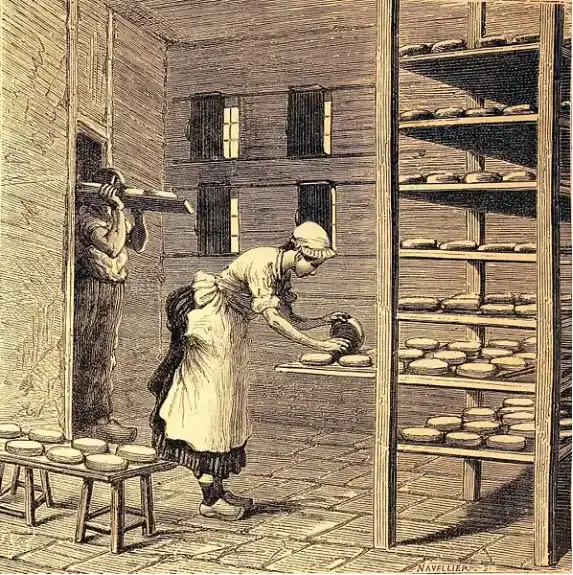Camembert, Revolutionary Cheese: How a Chance Encounter during the French Revolution Produced a Wonderful Cheese
You've probably heard of Camembert cheese before. He is the lesser-known younger brother of Brie cheese. According to the first origin stories, Brie cheese dates back to the fifth century, which makes Camembert cheese more than a thousand years younger, and is sometimes seen as nothing more than a by-product of Brie cheese. In this article, we talk about the origins of Camembert cheese, and the differences and similarities between it and its predecessor, Brie cheese...
Show key points
- Camembert cheese originated during the French Revolution when Marie Hamel inadvertently created it while attempting to make Brie using a priest’s recipe.
- Some historians trace early versions of Camembert cheese back to the Normandy Valley in the late 1600s, suggesting Marie Hamel may have simply refined an existing recipe.
- The cheese remained a local delicacy for years due to its soft texture and sensitivity to transport, only gaining national recognition after Napoleon sampled and named it.
- ADVERTISEMENT
- The Industrial Revolution, particularly the invention of the wooden box by engineer Riedel, enabled Camembert to be transported more safely and widely across France.
- Camembert earned its cultural significance in France partly due to its popularity among French soldiers during World War I who helped spread its acclaim after the war.
- Although it received the AOC status in 1983, only unpasteurized versions from Normandy can carry this designation, and most mass producers lost that status after switching to pasteurized milk.
- Camembert’s transformation over time included a change in rind color from green to white due to public awareness of germs, making it look more like Brie though their flavor, size, and texture differ significantly.
Start:

Legend has it that in 1791, in the midst of the French Revolution, a farmer named Marie Hamel took a priest to hide him from hordes of angry revolutionaries who wanted to kill him. This priest was from the town of Berri, or at least nearby, where he learned all the secrets of cheesemaking. In exchange for hiding it, or perhaps because they really wanted some cheese, he told her how to make excellent brie. During manufacturing, something went wrong, and the two instead created Camembert cheese.
Recommend
Another hypothesis is that there is evidence of Camembert cheese in the Normandy Valley, which can be traced back to the eighties of the seventeenth century. Perhaps Mary Hamel later improved the method or made a version that everyone liked the most. In its infancy and for several years afterwards, Camembert cheese was a local delicacy. Because cheese is soft, it is easy to damage during transportation. For this reason, it was mostly friends of Mary Hamel and nearby towns who ate it. In fact, no one even thought of naming cheese at this point. This remained so until the mid-nineteenth century, when Napoleon entered the picture. It seems that he was in the area and the locals offered him some cheese. Napoleon liked cheese very much and asked where it came from. When told the name of the village, he said, "Well, from now on you will be known as Camembert."
Universality:

The Industrial Revolution of the nineteenth century finally introduced Camembert's cheese to the world. We can thank modern transportation, the French engineer named Riedel for it. The proliferation of trains crossing the country and motorboats has given Camembert cheese a more reliable and smooth journey from place to place. But the real genius came from Riedel, who invented the wooden case in which it was placed. Even today, Camembert cheese is often sold in a wooden box used to transport it safely from one place to another.
It took a hundred years for Camembert cheese to emerge from its native land, and another thirty years for it to become a cultural part of the French scene. During World War I, Camembert cheese became a favorite of French soldiers, and when they returned home, they continued to claim it. The soldiers helped Camembert take its final steps to become fully integrated with the psyche of the French people.
Camembert cheese received the status of Appelation d'Origine Controlée (AOC) in 1983, a designation given to products that achieve lasting quality and continuity. Interestingly, while the origin of cheese is protected, the simple designation "Camembert" is not protected. Cheese can still be called by that name even if you do not follow AOC standards. If you want to make sure what kind of cheese you eat, you can take a look at the wooden box and look for the official AOC seal on it. As the official name suggests, Camembert cheese is made exclusively in Normandy on the northern border of France. The real sticking point between the two different versions is that AOC-controlled Camembert cheese must be made from unpasteurized milk. Due to health concerns, many Camembert producers have switched to pasteurized milk. In fact, two of the largest producers of Camembert switched to pasteurized milk in 2007. This has led to them losing their AOC status, reducing the number of official producers to five. Before the transition, these two companies produced 90 percent of France's Camembert. This makes this cheese strangely widespread but exclusive at the same time.
Camembert ripening:

Camembert is cooked on the surface, which means spraying its surface with Penicillum camemberti bacteria before leaving it to age for at least three weeks. This creates a white-colored crust (which you also see in Brie cheese). But in the time of Mary Hamel, the exterior of Camembert cheese was green or greenish-grey. Pierre Boisard, author of Camembert: A National Myth, discusses how newspapers and letters at the time routinely described Camembert in this way. The white crust as we know it did not develop until the twenties and thirties of the twentieth century. The author believes that this change in the color of the shell is related to Louis Pasteur and the theory of germs. Once people learned about the germs, they thought that green camembert looked moldy and unclean and began to prefer transgenic versions of white-scaled camembert. Today, all types of camemberts have white scales, and if you see one with a green crust, you should probably run in the opposite direction.
It is this change in white scales that makes Camembert and Brie cheese look similar at times. Both have a mature white crust on the surface. Is the only difference between them that Mary Hamel made her cheese green by mistake originally? Not quite. First, there's the volume. Brie cheese is usually made in wheels with a diameter of 22 to 37 centimeters, while Camembert cheese is about 10 centimeters in diameter, making it much smaller. During the production process, the cream is added to Brie cheese, giving it a higher fat content. Camembert, on the other hand, has stronger milky principles, which means Camembert has a stronger taste and aroma. There is also a difference when comparing dough: brie cheese is usually white and semi-soft on the inside but retains its shape, while camembert cheese is yellow on the inside, and at room temperature, the cambre is often fluid. Camembert has a more earthy taste than wild. It also contains hints of the taste of mushrooms and truffles. It must be aged for at least three weeks before being considered edible. The French like to eat camembert when it is at its best, after 30 to 35 days.

Camembert cheese is a coincidence. He can be considered the child of the French Revolution, born while France was getting rid of the monarchy. But now it is an adult, and it is in demand for its taste in many places, in France and abroad.








